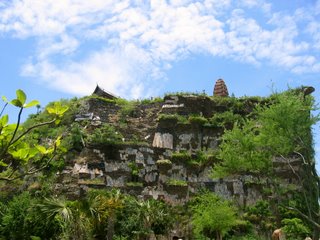Yesterday, Max and I visited Muang Boran, also known as the Ancient City. Located about 30 minutes outside of Bangkok, this attraction is billed as the Gateway to Thailand's Cultural Heritage.

Situated on a sprawling 320-acre compound (which when viewed from above resembles the shape of Thailand), the Ancient City features reconstructed historical buildings and smaller-scale reproductions of famous landmarks like the Grand Palace and other famous temples:



The famed Floating Market:

And the Giant Swing.

This is also a great place to look at ruins:



Sample Thai art:

See fine examples of traditional Thai homes and architecture:









Climb a mountain for a spectacular view:


And gaze upon statues and fountains based on Thai legends:




Of course, there are no shortage of Buddha images in the Ancient City.





Because several of the 116 spots of interest located in Muang Boran are indeed reproductions, some guidebooks dismiss this place as a tacky tourist trap and compare it to places like Las Vegas or Disney World. I found these comparisons a little off base and likened the place more to Greenfield Village in my hometown of Dearborn, Michigan (my friends and family back home will understand the comparison). Both places offer an insight into past history laid out in an accessible manner that's perfect for sight-seers.
There are several ways to get around the Ancient City. We chose to ride bicycles (you can borrow them for free). Because Max could not find a suitable bike out of the three or four hundred that were available, we opted for a bicycle-built-for-two. It was too small for me and didn't have any brakes, but it still made for a fun mode of transportation.

You can also rent golf carts, take a guided tour on a trolley or simply drive your car through. I would only recommending walking if you have the strong desire to drop dead from heat exhaustion.
We spent four hours at the Ancient City, but one could easily spend an entire day there if you wanted to read every sign and soak up all the culture and historical insights. I really enjoyed the place and would recommend it to anyone who is interested in a one-stop Bangkok sight-seeing trip.






















